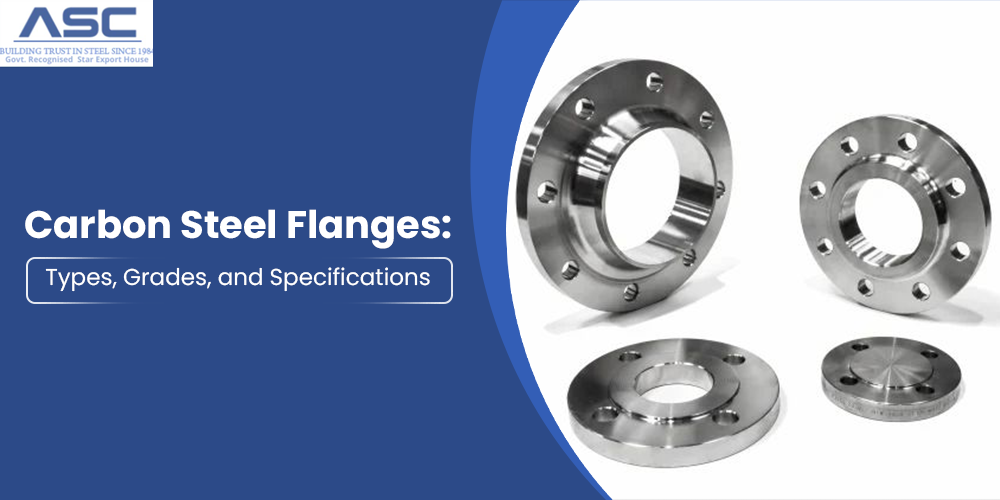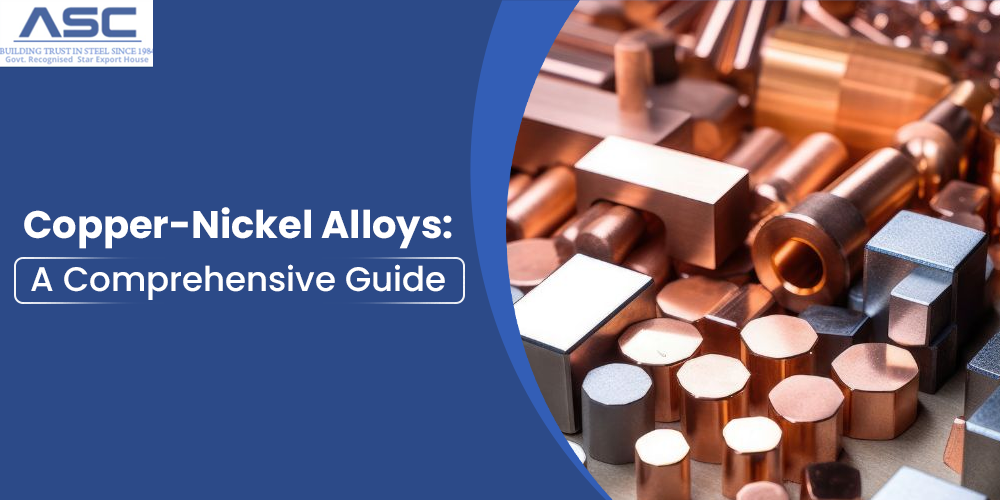Carbon Steel Flanges: Types, Grades, and Specifications
by AMC
Posted on October 01, 2024 at 13:40 PM

Carbon steel flanges play an essential role in piping systems, connecting pipes, valves, pumps, and other equipment to create a secure and leak-proof system. Known for their strength, durability, and cost-effectiveness, carbon steel flanges are widely used across various industries, including oil and gas, chemical, power generation, and more.
This guide will explore the different types of carbon steel flanges, their specifications, and the applications or uses they offer, helping you gain a better understanding of their importance in industrial operations.
Carbon steel flanges are a type of flange made from carbon steel, offering features like corrosion resistance, durability, and a smooth finish. They come in different types, each suited to specific applications. For example, carbon steel blind flanges are commonly used to close the end of a pipe.
Carbon steel flanges and end flange connectors are typically made from carbon steel. Some common standards for these include ASTM A694, ASTM A105N (SA105N), MSS SP-44, and DIN 2533. They are available with pressure ratings ranging from class 150 to 2500.
Carbon steel is a type of steel that contains up to 2.1% carbon by weight. According to AISI, it doesn't require a minimum amount of alloying elements like chromium, molybdenum, nickel, titanium, or vanadium. The copper content must be below 0.04%, and the maximum limits for manganese and silicon are 1.65% and 0.06%, respectively.
As the carbon content increases, the steel becomes harder and stronger after heat treatment. However, this also makes it less flexible. Without heat treatment, higher carbon content can reduce the steel’s ability to be welded. While not used as stainless steel, carbon steel may sometimes include alloy elements.
Functions of Carbon Steel Flanges
Forged flanges are commonly used in low-pressure applications. They have lower carbon content than cast flanges and are nonmagnetic. These flanges are lightweight with a flat design, yet they offer strong mechanical properties. However, if not forged properly, the material can develop uneven or coarse grains. Forged flanges are also harder to strengthen compared to cast flanges, which can be prone to cracking.
In the production of carbon steel flanges, the forging process plays a key role in ensuring that the sealing gasket functions correctly. This is vital for the proper performance of the flange. Forged flanges are made from high-quality materials and provide good insulation, protecting the carbon steel flange from corrosion and environmental damage. Their durable design and corrosion resistance make them highly effective in various applications.
Mild Steel or Low Carbon Steel Pipe Flanges
Carbon steel pipe flanges are often made from mild steel or low carbon steel, which contains a small amount of carbon. This makes the material strong and tough, though it is not easily tempered. Due to its lower cost, it can be used in a wide range of applications.
- Low carbon steel: Contains 0.005% to 0.3% carbon.
- Medium carbon steel: Contains 0.3% to 0.8% carbon.
- High carbon steel: Contains 0.8% to 2.0% carbon.
- Ultra-high carbon steel: Contains 1.25% to 2.0% carbon.
ASTM A105N (SA105N) Carbon Steel Pipe Flanges
ASTM A105 is a widely used material for forged carbon steel flanges, made from mild carbon steel. It is suitable for both ambient and high-temperature services in pressure systems. This material is known for its durability, cost-effectiveness, and resistance to breaking. When used in stainless steel piping systems, it requires a lap joint end ring to ensure compatibility.
Chemical Composition of A105 Carbon Steel Pipe Flanges
| Element | Composition,% |
|---|---|
| Carbon (C) | 0.35max |
| Manganese (Mn) | 0.60–1.05 |
| Phosphorus (P) | 0.035max |
| Sulfur (S) | 0.040max |
| Silicon (Si) | 0.10–0.35 |
| Copper (Cu) | 0.40max |
| Nickel (Ni) | 0.40max |
| Chromium (Cr) | 0.30max |
| Molybdenum (Mo) | 0.12max |
| Vanadium (V) | 0.08max |
Mechanical Properties of ASTM A105
| Mechanical Properties | Requirements |
|---|---|
| Tensile strength,min,psi [MPa] | 70000 [485] |
| Yield strength,min,psi [MPa] | 36000 [250] |
| Elongation, min, % | 30 |
| Reductionofarea,min,% | 30 |
| Hardness,HB,max | 187 |
Manufacturing Types and Standards of Carbon Steel Flanges
Carbon steel flanges can be produced through either forging or casting methods.
Differences Between Forged Steel Flanges and Cast Iron Flanges
- Cost: The forging process is generally more expensive than casting.
- Complexity: Cast iron can be shaped to fit complex designs, while forged steel flanges have limitations in design.
- Grain Structure: Forging does not produce large or uneven grains.
- Application: Cast iron flanges are typically used in non-pressure pipelines, while forged steel flanges are suitable for high-pressure applications.
- Precision: A centrifugal machine can create high-precision cast iron flanges compared to standard cast flanges.
- Strength: Forged steel is easier to cut and has higher tensile strength.
- Performance: Overall, forged steel flanges outperform cast iron flanges due to better shape and lower carbon content, which reduces rusting.
Referred Standards
- B16.5: Dimensional standard for steel pipe flanges and fittings.
- B16.34: Standards for valves connected by flanges, threaded, and welded ends.
- B16.47: Standards for large diameter steel flanges.
- SP44: Standard for steel pipeline flanges.
- API 605: Standards for large diameter carbon steel flanges.
Coating Type
To protect carbon steel flanges from rust and corrosion, various coatings can be applied:
- Anti-rust painting
- Oil varnish
- Electric zinc coating (available in white or yellow zinc)
- Alloy material coating (lined or clad)
Carbon Steel Flange Types
- Weld Neck Flange
- Slip On Flange
- Blind Flange
- Socket Weld Flange
- Threaded Flange
- Reducing Flanges

Blind Flange

Lap Joint Flange

Slip On Flange

Weld Neck Flange

Socket Weld Flange

Threaded Flange
Carbon Steel Flanges Grades
The main grades of carbon steel flanges include ASTM A516, ASTM A694, ASTM A350, ASTM A182, and ASTM A105. The carbon content in these flanges typically ranges from 1% to 2%. Higher carbon content increases the stiffness and strength of the steel but reduces its ductility. Additionally, high carbon levels can make welding more difficult if the steel isn't treated at high temperatures.
Carbon Steel A105 Flanges
Carbon steel A105 flanges are forged components used in pressure systems involving fittings, flanges, and valves, particularly at high temperatures. They can operate effectively in temperature ranges from 0 to 550 degrees Fahrenheit. These flanges are suitable for marine and hydrocarbon engineering processes, and they are commonly found in gas, oil, nuclear power plants, pump manufacturing, and petrochemical industries.
Carbon Steel A350 LF2 Low-Temperature Flanges
Carbon steel A350 LF2 flanges are designed for low-temperature applications. They are made with forged fittings, low-alloy steel forged valves, and ring-rolled carbon flanges. These flanges are known for their pressure resistance, strength, and durability. They provide good machinability when forged and hardened, offering moderate strength and high demand due to their hardness.
Carbon Steel Low Alloy A182 Flanges
The A182 grade is used for stainless steel pipe valves, flanges, and other high-temperature services. These flanges are well-suited for low-corrosion applications and have a slow wear rate. They are widely used in industries such as petroleum, paper, and chemicals. Their long lifespan and low maintenance needs make them a reliable choice, especially for the paper industry. Purchasing from a reputable supplier, like Texas Flanges, ensures better durability.
Carbon Steel A694 Flanges
A694 flanges are designed for high-stress applications, particularly in high-pressure oil and gas transmission. The steel produced must withstand both cryogenic and high temperatures. An increase in carbon content, along with heat treatment, makes the material less ductile. Without heat treatment, the steel's weldability can also be compromised.
Uses of Carbon Steel Flanges
Carbon steel is an alloy made primarily of iron and carbon. In pure carbon steel, only a few additional elements are allowed: manganese (up to 1.65%), silicon (up to 0.60%), and copper (up to 0.60%). As the carbon content increases, carbon steel flanges become harder and stronger. However, higher carbon content can lower the melting point and temperature tolerance of the flanges, making them more challenging to weld due to reduced robustness and ductility.
Carbon steel flanges are widely used in various applications, including:
- Piping Systems: Connecting pipes, valves, and other equipment in water, oil, and gas pipelines.
- Pressure Vessels: Used in industries such as oil and gas, chemical processing, and power generation.
- Marine Engineering: Suitable for applications exposed to harsh marine environments.
- Manufacturing Equipment: Common in pump manufacturing, petrochemical plants, and nuclear power facilities.
Their strength and versatility make carbon steel flanges an essential component in many industrial settings.
Conclusion
Carbon steel flanges are vital components in various industrial applications, offering strength, durability, and versatility. With different grades like ASTM A105, A350, A694, and A182, each flange type is designed to meet specific requirements, whether for high-pressure systems, low-temperature applications, or resistance to corrosion. Understanding the properties and uses of carbon steel flanges allows industries to make informed choices for their piping and equipment needs.
As we’ve explored, the manufacturing process—whether forging or casting—impacts performance, cost, and application suitability. Additionally, the right coatings and standards ensure that these flanges can withstand the challenges of their environments. By choosing high-quality carbon steel flanges from reputable suppliers like Amardeep Steel, a leading supplier in India, businesses can enhance the reliability and efficiency of their systems, ultimately leading to better performance and longevity.

Copper-Nickel vs. Stainless Steel
When selecting a material for your next project, several factors need to be weighed, including cost, durability, and corrosion resistance.

